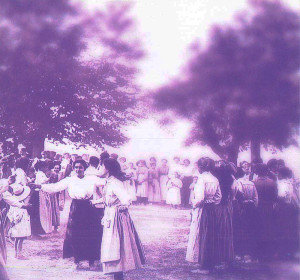The dancing or erromeria was held every Sunday and holiday afternoon; on Sundays it lasted until the sound of the church bells at eight or nine o’clock in the evening, abemariak, was heard, and until midnight during the festivities in honour of the patron saint. The dancing venue was the meeting place for young girls and boys, a superb opportunity for making new acquaintances and meeting with the group of friends.
The village square was usually the preferred location for the weekly dance or jolasa, but pelota courts and fields too served the purpose; local religious festivals were often celebrated around hermitages. At the beginning of the last century these were the most popular dances: biribilketa, jota or fandangoa and arin-arina or porrusalda. Besides those dances meant to be danced without holding a partner, dantza lotua or baltseoa, were danced cheek to cheek: to start with, girls danced with each other and later on boys joined in as dancing partners. They danced to the beat of the txistua (three-hole pipe) and the danbolina (small drum) or the soinua (accordion), the trikitixa (small accordion) and the panderoa (tambourine), and a diverse range of folk instruments.
Jota and arin-arina were danced either in pairs or in a circle. The musicians would often sing the lyrics and the dancers joined them and sung stanzas that they ended up knowing by heart.
The old traditional stanza called kopla is the firm foundation on which Basque popular literature (wassail songs, serenades, bedtime songs, and so on) stands. Kopla songs sung in weekly dances and annual festivals have distinctive features both from a structural point of view and as regards the topics dealt with. The stanzas are structured based on the music and the dance in question, hence the repetition of sentences and phrases, the use of exclamation voices and vocatives, etc. The motives are related to the joyful environment of the dance: the relationships between girls and boys, laugh-provoking characters, somewhat vulgar remarks and frequent scatological references. The singer would normally build a set of stanzas on a certain topic of discussion and link it with a following set, perhaps a new topic associated to the former, often cross-referencing. He would usually start with a greeting line, “Hastera noa, hastera” (I am about to start), and end with a farewell formula, “Hau dala bai bukaera, bukaeraren tristea” (This is sadly the end).



